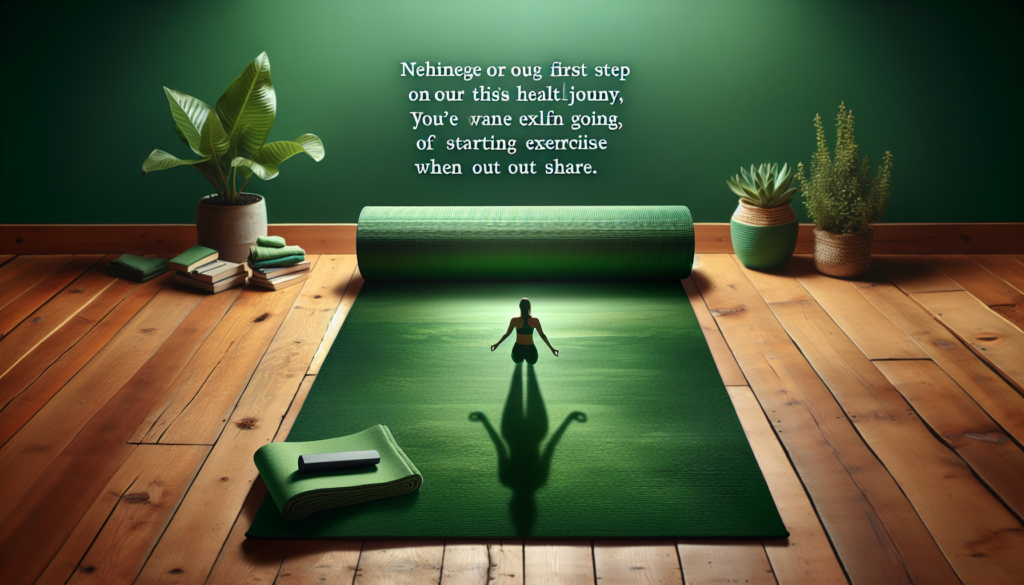How to Start Exercising When You’re Out of Shape
So, you’ve decided that it’s time to start exercising, but there’s just one tiny issue: you’re out of shape. Don’t worry, because in this article, we’re going to show you exactly how you can get started on your fitness journey, regardless of your current physical condition. We understand that taking that first step can be intimidating, but with the right mindset and approach, you’ll be well on your way to improving your fitness levels and feeling healthier. Let’s get started!

Choosing the Right Exercise
When you’re starting a fitness journey, it’s important to first identify your fitness goals. What do you want to achieve through exercise? Are you looking to lose weight, build muscle, increase flexibility, or simply improve your overall health and well-being? Once you have a clear understanding of your goals, you can tailor your exercise routine accordingly.
In addition to your goals, it’s also crucial to consider your preferences. What types of activities do you enjoy? Do you prefer solo workouts or group classes? By choosing exercises that you genuinely enjoy, you’ll be more likely to stick with them in the long run. Whether it’s jogging, yoga, dancing, or swimming, find something that excites you and makes you eager to move your body.
Before starting any new exercise program, it’s always wise to consult a healthcare professional, especially if you have any underlying health conditions or injuries. They can provide valuable advice and guidance on how to exercise safely and effectively. Your healthcare provider may also be able to recommend specific exercises or modifications that are suitable for your individual needs and capabilities.
Starting Slowly
When you’re out of shape or just getting started with exercise, it’s important to set realistic expectations. Rome wasn’t built in a day, and the same goes for your fitness journey. Start by acknowledging your current fitness level and gradually work your way up from there. It’s okay to start small and progress at your own pace.
Consistency is key when it comes to exercise. Rather than pushing yourself too hard during a single workout, focus on being consistent with your exercise routine. Aim to incorporate physical activity into your daily life, even if it’s just for a few minutes each day. Consistency will help build a foundation of fitness and create lasting habits.
To avoid overwhelming your body when you’re just starting out, it’s advisable to begin with low-impact activities. These exercises are gentle on your joints and muscles, making them ideal for beginners. Walking, swimming, cycling, and using an elliptical machine are all great options. As your fitness level improves, you can gradually increase the intensity and incorporate higher-impact exercises into your routine.
Warming Up and Cooling Down
Warming up your body before exercise and cooling down afterward are crucial steps in any workout routine. A proper warm-up helps increase blood flow to your muscles, raises your body temperature, and prepares your body for more intense activity. Cooling down, on the other hand, helps to gradually lower your heart rate and prevent muscle soreness.
Dynamic stretching is an effective way to warm up your muscles before a workout. Perform movements that gently move your joints and muscles through their full range of motion. This can include exercises like arm circles, leg swings, and shoulder rolls. Dynamic stretching helps improve joint flexibility and loosens up your muscles, reducing the risk of injury.
For the warm-up portion of your workout, engaging in light cardio exercises is beneficial. This could involve five to ten minutes of walking, jogging in place, or cycling at a relaxed pace. The goal is to raise your heart rate gradually and prepare your body for the more intense exercises to come.
After completing your workout, static stretching is ideal for cooling down. Hold stretches for 15-30 seconds, focusing on the major muscle groups you engaged during your workout. This helps improve flexibility and prevent muscle stiffness. Stretching can include exercises such as touching your toes, reaching overhead, or a seated hamstring stretch.
Building Stamina Gradually
As you progress in your fitness journey, it’s important to gradually increase the duration of your workouts. This allows your body to adapt and become more conditioned over time. Start by adding a few minutes to your exercise routine every week or every other week, depending on your comfort level. Aim to find a balance between pushing yourself and avoiding burnout.
Incorporating interval training into your workouts can be a great way to build stamina. This involves alternating between periods of high-intensity exercise and periods of active recovery. For example, you could sprint for 30 seconds and then walk or jog for one minute. This type of training improves cardiovascular fitness, burns calories, and helps increase endurance.
High-intensity interval training (HIIT) is another effective way to build stamina. HIIT workouts involve short bursts of intense exercise followed by brief recovery periods. These workouts are known for their efficiency and can be completed in a shorter amount of time compared to traditional cardio workouts. Examples of HIIT exercises include burpees, mountain climbers, and squat jumps.

Strength Training
Strength training is an essential component of any well-rounded exercise routine. Not only does it help build muscle mass, but it also increases bone density and boosts metabolism. When starting out, it’s best to begin with bodyweight exercises that utilize your own body as resistance.
Exercises like push-ups, squats, lunges, planks, and tricep dips can all be done without any equipment. They target multiple muscle groups simultaneously and help improve overall strength. Start with a few repetitions of each exercise and gradually increase the number of sets and reps as you get stronger.
To challenge yourself further and continue building strength, you can incorporate resistance bands or weights into your routine. Resistance bands are versatile, affordable, and can be used to target specific muscle groups. Dumbbells, barbells, or kettlebells are other options if you prefer to use traditional weights.
Including compound exercises in your strength training routine can be highly beneficial. Compound exercises engage multiple muscle groups at once and mimic movements used in daily life. Examples include squats, deadlifts, bench presses, and bent-over rows. These exercises help improve overall functional strength and increase calorie burn.
Finding Accountability and Support
While exercising on your own can be motivating, having accountability and support can make a world of difference in staying consistent and reaching your fitness goals. If you find it challenging to stay motivated, here are a few options to consider:
Exercising with a buddy can provide the support and encouragement you need to stay on track. Find a friend or family member who has similar fitness goals and schedule regular workout sessions together. Not only will you have someone to hold you accountable, but exercising with a partner can also make workouts more enjoyable.
Joining a fitness class or group can provide a sense of community and camaraderie. Whether it’s a yoga class, a dance class, or a group fitness class, being surrounded by like-minded individuals can boost motivation and make exercising more fun. Additionally, instructors and fellow participants can offer guidance and support along the way.
If you feel the need for personalized guidance and motivation, hiring a personal trainer may be a great option. A qualified trainer can create a customized workout plan tailored to your goals and fitness level. They can also help you learn proper exercise techniques, prevent injuries, and provide ongoing support and accountability.
Creating a Schedule
To ensure that exercise becomes a regular habit in your life, it’s important to create a schedule that works for you. Choose a time of day when you have the most energy and are least likely to be interrupted. This could be early in the morning, during your lunch break, or in the evening after work.
While it’s essential to be consistent with your workouts, it’s equally important to plan for rest days. Rest days allow your body to recover and repair itself, which is crucial for avoiding burnout and preventing injuries. Aim to have at least one or two rest days per week to give your body the time it needs to rest and rebuild.
Keeping a workout journal can be a helpful tool for staying on track and monitoring your progress. Write down the exercises you do, the duration, and any notes or observations about how you felt during the workout. This can help you identify patterns, track improvements, and stay motivated as you see your progress over time.
Staying Motivated
Maintaining motivation can be a challenge, especially when life gets busy or when you hit a plateau in your progress. Here are a few strategies to help you stay motivated and consistent with your exercise routine:
Setting achievable short-term goals can keep you focused and motivated. Instead of solely focusing on the long-term goal, break it down into smaller milestones. For example, aim to increase the number of push-ups you can do or improve your running pace by a certain percentage. Celebrate these small victories along the way to keep your motivation high.
Rewarding yourself can be a powerful motivator. Treat yourself to something you enjoy after reaching a milestone or completing a certain number of workouts. It could be a massage, a new workout outfit, or even a day off where you indulge in your favorite activities. Having something to look forward to can make the journey more enjoyable.
Tracking your progress is essential to stay motivated. Keep a record of your workouts, measurements, and any other relevant data. This could include things like weight loss, increased stamina, or improved flexibility. Seeing tangible evidence of your progress can be a tremendous source of motivation and encourage you to keep pushing forward.
Listening to Your Body
Listening to your body is vital to staying safe and preventing injuries. Pay attention to any discomfort or pain during exercise. While it’s normal to experience muscle soreness, sharp or intense pain could be a sign of a more serious issue. If you experience pain that doesn’t subside with rest or that worsens, it’s important to consult a healthcare professional.
Adjusting the intensity of your workouts as needed is crucial, especially when you’re starting out or returning from a break. It’s okay to take things at your own pace and modify exercises to accommodate your fitness level. Remember, progress is not linear, and it’s important to honor where your body is at in each moment.
Rest is an essential part of any exercise routine. Your body needs time to recover and rebuild after intense workouts. If you’re feeling fatigued, excessively sore, or mentally drained, it may be a sign that you need to take a day or two off from exercising. Rest and recovery are just as important as the workouts themselves.
Maintaining a Healthy Lifestyle
Exercise is just one piece of the puzzle when it comes to maintaining a healthy lifestyle. It’s crucial to balance exercise with proper nutrition, adequate sleep, and hydration. These factors all work together to support your overall health and well-being.
Eating a balanced diet that includes a variety of nutrient-rich foods is important for fueling your workouts and promoting recovery. Aim to consume lean proteins, whole grains, fruits, vegetables, and healthy fats. Stay hydrated by drinking plenty of water throughout the day, especially before, during, and after workouts.
Getting enough sleep is crucial for your body’s recovery and helps support overall health. Aim for seven to nine hours of sleep each night, as it allows your body to repair tissues, regulate hormones, and maintain optimal cognitive function. Quality sleep is essential for feeling energized and ready to tackle your workouts.
In conclusion, starting an exercise routine when you’re out of shape doesn’t have to be overwhelming or intimidating. By choosing the right exercise, starting slowly, warming up and cooling down properly, and gradually building stamina, you can embark on your fitness journey with confidence. Strength training, finding accountability and support, creating a schedule, staying motivated, listening to your body, and maintaining a healthy lifestyle are all key components to sustain your progress and enjoy the benefits of regular exercise. Remember, it’s not about achieving perfection but rather making progress and taking care of your overall well-being. So lace up your sneakers, embrace the journey, and enjoy the transformative power of exercise on your mind, body, and soul!

















It's great that you talked about how business insurance can provide financial protection against unexpected events and help ensure the…
I like that you mentioned how business insurance is essential for protecting your bottom line and the long-term viability of…